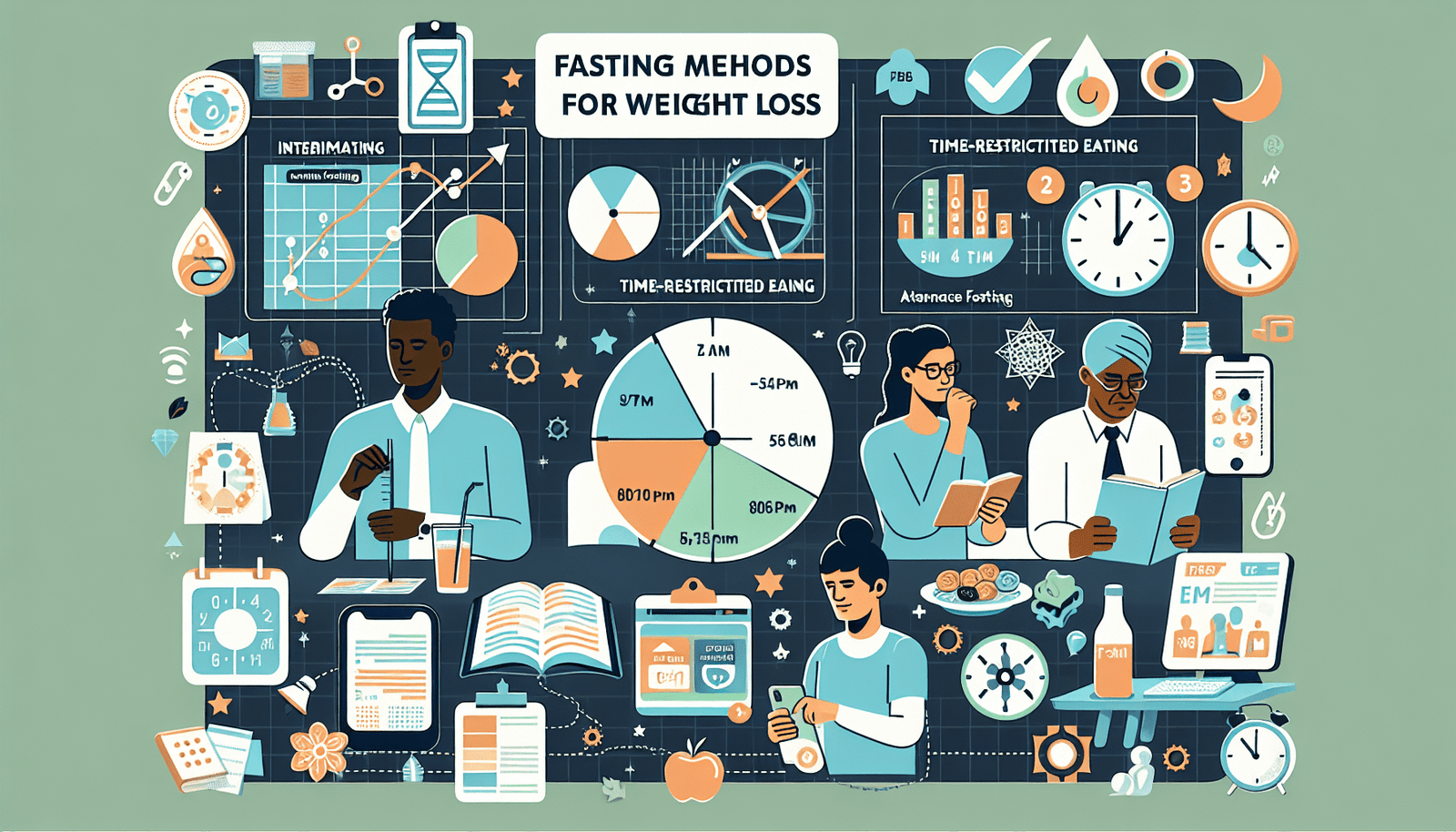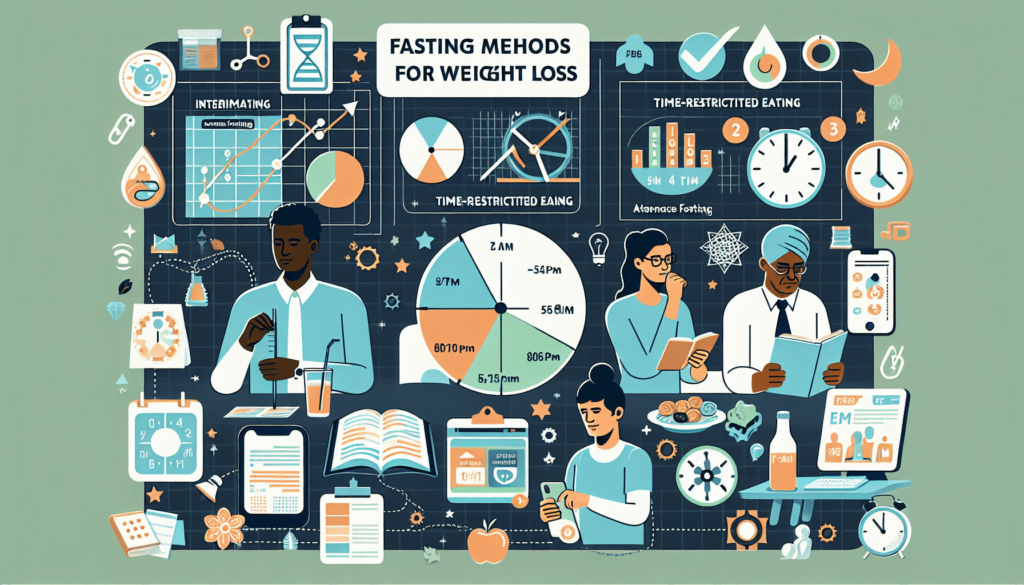Looking to shed some pounds quickly? Look no further. In this article, we’ll explore the best fasting methods for quick weight loss. Whether you’re a seasoned faster or new to the concept, these effective fasting methods are sure to help you reach your weight loss goals in no time. Say goodbye to crash diets and hello to a healthier, more sustainable approach to losing weight. So sit back, relax, and discover how fasting can be the key to achieving the body you’ve always desired.

Intermittent Fasting
What is intermittent fasting?
Intermittent fasting is a dietary approach that involves alternating periods of eating and fasting. It does not restrict the types of foods you can eat but rather focuses on the timing of meals. During the fasting periods, you consume little to no calories, allowing your body to utilize stored fat as a source of energy.
Types of intermittent fasting
There are several popular methods of intermittent fasting. The most common ones include the 16/8 method, where you fast for 16 hours and have an eight-hour eating window, the 5:2 diet, which involves eating normally for five days and restricting calorie intake to 500-600 for two non-consecutive days, and the Eat-Stop-Eat method, where you fast for 24 hours once or twice a week.
Benefits of intermittent fasting for weight loss
Intermittent fasting has gained popularity as an effective weight loss method due to its various benefits. Firstly, it helps create a calorie deficit by reducing the overall number of calories consumed. Additionally, fasting has been shown to increase fat burning and boost metabolism. It can also improve insulin sensitivity, which is essential for maintaining stable blood sugar levels and preventing weight gain. Furthermore, intermittent fasting can lead to reduced inflammation, improved brain function, and enhanced cellular repair processes.
Tips for successful intermittent fasting
To make the most of your intermittent fasting journey, it’s essential to follow a few tips. Firstly, listen to your body and choose a fasting method that works best for you. Experiment with different eating windows and see what feels sustainable and comfortable. Stay well-hydrated during fasting periods, as water helps control hunger and supports overall health. It’s also important to focus on nutrient-dense foods during your eating windows, as this will ensure you are getting essential vitamins and minerals. Lastly, be patient and give your body time to adjust to the fasting routine, as results may vary for each individual.
Water Fasting
What is water fasting?
Water fasting involves abstaining from consuming any food or caloric beverages and relying solely on water for a designated period. It is considered an extreme form of fasting but has gained popularity due to its potential health benefits and ability to kickstart weight loss.
How water fasting promotes weight loss
Water fasting promotes weight loss through the same mechanism as other fasting methods: creating a calorie deficit. By completely eliminating calorie intake and relying on stored fat for energy, your body enters a state of ketosis, where fat cells are broken down to provide fuel. This leads to rapid and significant weight loss.
Health benefits of water fasting
Apart from weight loss, water fasting is believed to have other health benefits. It can help improve insulin sensitivity and regulate blood sugar levels, potentially reducing the risk of type 2 diabetes. It may also support autophagy, a natural process where the body removes and recycles damaged cells, leading to potential anti-aging effects. Additionally, water fasting is thought to promote mental clarity and can provide a reset for unhealthy eating habits.
Important considerations and precautions
Water fasting is an extreme fasting method that should be approached with caution. It is essential to consult with a healthcare professional before attempting a water fast, especially if you have any underlying medical conditions. Extended periods of water fasting may lead to electrolyte imbalances, dehydration, and nutrient deficiencies. It is crucial to listen to your body and stop the fast if you experience severe symptoms such as dizziness, weakness, or rapid heart rate.
Alternate-Day Fasting
What is alternate-day fasting?
Alternate-day fasting involves alternating between regular eating days and fasting days. On fasting days, calorie consumption is significantly restricted, usually to around 500-600 calories. This fasting method allows for some flexibility in terms of food choices on eating days while incorporating a structured fasting routine.
How alternate-day fasting works for weight loss
Alternate-day fasting promotes weight loss by creating a calorie deficit on fasting days. By restricting calorie intake every other day, you reduce your overall calorie intake, leading to weight loss over time. The method also triggers various metabolic adaptations that can enhance fat burning and improve overall metabolic health.
Benefits and potential drawbacks of alternate-day fasting
One of the main benefits of alternate-day fasting is its simplicity and flexibility. You don’t have to follow rigid meal plans or restrict specific food groups. Additionally, some studies suggest that alternate-day fasting may improve markers of cardiovascular health, such as reducing blood pressure and cholesterol levels. However, alternate-day fasting may not be suitable for everyone, as the strict fasting days can be challenging to adhere to and may lead to overeating on eating days. It is important to assess your individual needs and consult a healthcare professional before starting this fasting method.
Recommended practices for alternate-day fasting
To have a successful experience with alternate-day fasting, it’s important to establish a routine and find strategies that work for you. Planning meals ahead of time on eating days can help prevent overeating and make healthier choices. It’s also beneficial to stay well-hydrated throughout the fasting days to control hunger and support overall health. Lastly, prioritize nutrient-dense foods on eating days to ensure you are getting essential vitamins and minerals.

Time-Restricted Eating
What is time-restricted eating?
Time-restricted eating involves limiting your daily eating window to a specific number of hours and fasting for the remaining hours. The most common approach is the 16/8 method, where you fast for 16 hours and have an eight-hour eating window. This fasting method can be easily incorporated into daily routines and is a popular choice for those seeking weight loss.
How time-restricted eating aids in weight loss
Time-restricted eating aids in weight loss primarily by limiting the number of hours in which you can consume calories. By shortening your eating window, you naturally reduce the opportunity to overeat and create a calorie deficit. Additionally, time-restricted eating has been shown to improve insulin sensitivity, reduce inflammation, and promote fat burning.
Optimal time windows for time-restricted eating
The timing of the eating window can be flexible, depending on personal preferences and schedules. The 16/8 method is a widely used approach, where individuals typically start their fast after dinner and skip breakfast, having their first meal around lunchtime. However, the timing can be adjusted according to individual needs. It is important to find a time window that aligns with your lifestyle and allows for consistent adherence.
Tips for implementing time-restricted eating
When implementing time-restricted eating, it’s helpful to start gradually and allow your body to adjust to the new eating schedule. Begin by shortening your eating window by an hour each day until you reach your desired fasting duration. Experiment with different eating and fasting times to find the schedule that works best for you. Additionally, staying hydrated during the fasting period can help manage hunger and keep you feeling satisfied. As with any fasting method, it’s important to listen to your body and modify the approach if you experience any adverse effects.
The 5:2 Diet
What is the 5:2 diet?
The 5:2 diet, also known as the Fast Diet, involves eating normally for five days a week and restricting calorie intake to 500-600 for two non-consecutive days. This approach allows for flexibility on eating days while still incorporating regular fasting periods.
How the 5:2 diet facilitates weight loss
The 5:2 diet facilitates weight loss by creating a calorie deficit during the fasting days. By dramatically reducing calorie intake for two days a week, you reduce your overall calorie intake, leading to weight loss. The fasting days also help improve insulin sensitivity and enhance fat burning.
Advantages and limitations of the 5:2 diet
One of the advantages of the 5:2 diet is its flexibility. You can choose which days to fast based on your schedule and preferences, allowing for easier adherence. Additionally, the 5:2 diet may have similar benefits to other fasting methods, such as improved metabolic health and reduced inflammation. However, some individuals may find the fasting days challenging, and it may take time to adjust to the lower calorie intake. It’s important to assess your personal needs and preferences and consult a healthcare professional before starting the 5:2 diet.
Meal planning and tips for the 5:2 diet
Meal planning can be crucial for success on the 5:2 diet. On fasting days, focus on consuming low-calorie, nutrient-dense foods to optimize nutrition while keeping calorie intake low. Incorporate plenty of vegetables, lean proteins, and healthy fats to ensure your body receives essential nutrients. Additionally, spreading out smaller meals or snacks throughout the fasting day can help manage hunger and keep you feeling satisfied. It’s important to listen to your body and adjust the fasting day calorie intake based on individual needs and preferences.
Modified Fasting Methods
What are modified fasting methods?
Modified fasting methods are variations of traditional fasting approaches that allow for some flexibility in terms of intake during the fasting period. These methods may still restrict calorie intake but often allow for the consumption of specific foods or beverages that do not interfere significantly with the fasting state.
Different types of modified fasting
There are several types of modified fasting methods, including the fat fasting approach, where you consume only fatty foods while avoiding carbohydrates and protein, and the bone broth fast, where you consume mainly bone broth and other low-calorie, nutrient-dense liquids. Some individuals also incorporate fasting-mimicking diets, which provide a specific ratio of macronutrients to induce fasting-like effects while still providing some calories.
Effectiveness of modified fasting for weight loss
Modified fasting methods can be effective for weight loss, albeit to a lesser extent than traditional fasting approaches. By still restricting calorie intake during the fasting period, modified fasting methods create a calorie deficit that can lead to weight loss. However, the specific results may vary depending on individual factors, adherence, and the specific method employed.
Precautions and considerations for modified fasting
When considering modified fasting methods, it is essential to evaluate the specific approach and its potential impact on overall health. Some modified fasting methods may be more restrictive or nutritionally imbalanced, which can increase the risk of nutrient deficiencies. It is crucial to consult with a healthcare professional or registered dietitian to ensure that any modified fasting method is safe and suitable for your individual needs.
Extended Fasting
What is extended fasting?
Extended fasting refers to prolonged periods of fasting, typically lasting 24 hours or longer. This approach goes beyond the intermittent fasting methods mentioned earlier and can be a more intense fasting experience. Extended fasting is often used as a therapeutic tool rather than a regular weight loss method.
How extended fasting accelerates weight loss
Extended fasting accelerates weight loss by pushing the body into a deeper state of ketosis. During prolonged fasting, your body exhausts its glycogen stores and switches to burning stored fat for energy. This can lead to more rapid weight loss compared to shorter fasting periods.
Potential benefits and challenges of extended fasting
While extended fasting can promote significant weight loss, it is important to consider the potential benefits and challenges. Extended fasting may support autophagy, the natural cellular repair process, and has been associated with reduced inflammation. However, extended fasting can be mentally and physically demanding. It requires careful attention to hydration, electrolyte balance, and potential symptoms of refeeding syndrome, a condition that can occur when resuming eating after a prolonged fast. Extended fasting should be approached cautiously and under medical supervision.
Important guidelines for successful extended fasting
To have a successful extended fasting experience, it is crucial to follow important guidelines. Prioritize hydration by drinking plenty of water throughout the fasting period. If fasting longer than 48 hours, consider supplementing electrolytes to maintain proper balance. Rest and allow your body to conserve energy during extended fasting, avoiding excessive physical activity. Lastly, when breaking an extended fast, start with small, easily digestible meals to allow your body to adjust gradually.
Juice Fasting
What is juice fasting?
Juice fasting involves consuming only juices made from fresh fruits and vegetables while abstaining from solid food. This fasting method provides essential nutrients while minimizing calorie intake, promoting weight loss and potentially offering other health benefits.
How juice fasting promotes weight loss
Juice fasting promotes weight loss by reducing calorie intake while still providing essential vitamins, minerals, and antioxidants found in fruits and vegetables. Juices are typically lower in calories compared to solid foods, allowing for a calorie deficit and subsequent weight loss. The high water and fiber content in juices can also help control hunger and support digestion.
Benefits and cautions of juice fasting
Juice fasting can provide various benefits beyond weight loss. The abundance of vitamins and minerals in fresh juices can support overall health and may boost the immune system. The increased intake of fruits and vegetables can also enhance nutrient absorption and provide a nourishing detox effect. However, it is important to note that juice fasting may lack certain nutrients found in whole foods, such as fiber and protein. Additionally, the high sugar content in some fruit juices may negatively impact blood sugar levels. As with any fasting method, it is important to listen to your body and consult with a healthcare professional before embarking on a juice fast.
Suggestions to maximize the effectiveness of juice fasting
To maximize the effectiveness of juice fasting, opt for a variety of fruits and vegetables to ensure a wide range of nutrients. Incorporate more vegetables than fruits to keep sugar levels in check. It is also beneficial to consume freshly squeezed juices rather than store-bought options, as they may contain added sugars or preservatives. Lastly, consider incorporating homemade nut milks or vegetable broths alongside juices to provide additional nutrients and support overall satiety.
Protein Sparing Modified Fasting
What is protein sparing modified fasting?
Protein sparing modified fasting, or PSMF, is a type of fasting that restricts calorie intake while ensuring an adequate protein intake. It aims to preserve lean muscle mass while promoting weight loss by primarily utilizing fat stores for energy.
How protein sparing modified fasting aids in weight loss
Protein sparing modified fasting aids in weight loss by creating a significant calorie deficit while providing sufficient protein to preserve muscle mass. By limiting calories, especially from carbohydrates and fats, and maintaining an adequate protein intake, your body is forced to break down stored fat for energy. This can lead to rapid and significant weight loss.
Pros and cons of protein sparing modified fasting
One of the main advantages of protein sparing modified fasting is its ability to preserve muscle mass during weight loss. This can be particularly beneficial for individuals looking to achieve significant weight loss while maintaining lean body mass. Additionally, PSMF can provide quick results, which can be motivating for some individuals. However, this type of fasting can be challenging to sustain long-term due to its strict nature and potential nutrient deficiencies. It is essential to approach protein sparing modified fasting with caution and under medical supervision.
Important considerations for protein sparing modified fasting
When embarking on a protein sparing modified fasting regimen, it is crucial to prioritize nutrient density. Including a variety of lean proteins, non-starchy vegetables, and healthy fats can help ensure you are meeting your nutritional needs. As with any fasting method, it is important to listen to your body and adjust the approach if you experience any adverse effects. Consulting with a healthcare professional or registered dietitian is recommended, especially if you have any medical conditions or concerns.
Combining Fasting with Exercise
Benefits of combining fasting with exercise for weight loss
Combining fasting with exercise can amplify weight loss results and provide additional health benefits. When exercising in a fasted state, your body relies on stored fat as an energy source, leading to increased fat burning and accelerated weight loss. Fasting can also enhance exercise performance by improving insulin sensitivity and reducing inflammation.
Recommended exercises to maximize results
To maximize results when combining fasting with exercise, it is recommended to focus on a combination of aerobic exercises and resistance training. Aerobic exercises such as running, swimming, or cycling can help burn calories and improve cardiovascular fitness. Resistance training, including weightlifting or bodyweight exercises, can build lean muscle mass and boost metabolism. High-intensity interval training (HIIT) is another effective option, as it combines cardiovascular and strength elements in short, intense bursts.
Precautions and tips for exercising during fasting
When incorporating exercise into your fasting routine, it’s crucial to listen to your body and adjust accordingly. Start with low to moderate intensity workouts if you are new to fasting. Stay well-hydrated throughout your exercise session, and consider breaking your fast with a balanced meal containing both protein and carbohydrates to support muscle recovery. Pay attention to any signs of fatigue, dizziness, or lightheadedness, as these could indicate the need to modify your fasting or exercise routine. If you have any concerns, it is recommended to consult with a healthcare professional or certified fitness trainer.
Sample workout routines for fasting days
Here are a few sample workout routines you can try on fasting days, depending on your fitness level and preferences:
- Beginner Routine: Start with a 30-minute brisk walk or light jog. Perform bodyweight exercises such as squats, lunges, push-ups, and planks for 10-15 minutes.
- Intermediate Routine: Begin with a 20-minute jog or inclined treadmill walk. Follow with a circuit of strength exercises, including dumbbell lunges, bench press, bent-over rows, and shoulder presses for 20-30 minutes.
- Advanced Routine: Warm up with a 10-minute jog or jump rope session. Proceed with HIIT intervals, alternating between 60 seconds of high-intensity exercises (burpees, mountain climbers) and 60 seconds of rest for a total of 15-20 minutes. Finish with a 15-minute cooldown jog or stretch session.
Remember to modify and adjust these routines based on your fitness level and personal preferences. Listening to your body and prioritizing safety is key when combining fasting with exercise.








